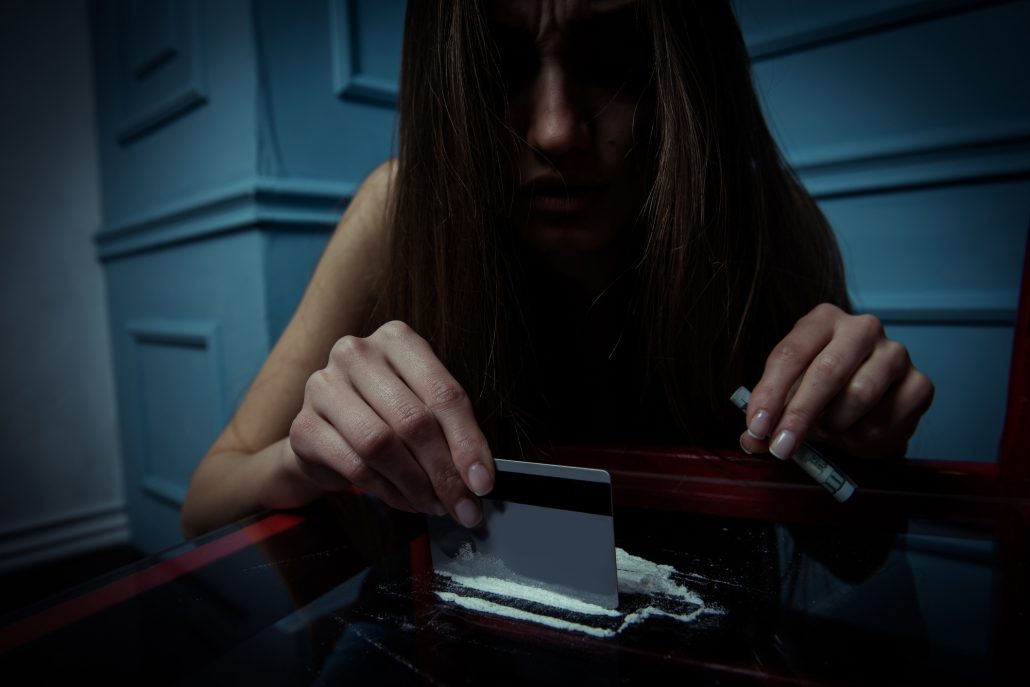by staff | Aug 7, 2017 | Addiction Treatment, Detox, Drug Abuse, Recovery, Withdrawal

(This content is being used for illustrative purposes only; any person depicted in the content is a model)
Repeated and extended use of most drugs can cause physical dependence to develop quickly in the body, and while many people experience symptoms of dependence differently, once it has been established there are typically a number of uncomfortable or even painful adverse effects. Many of these side-effects, specifically withdrawal symptoms, happen when trying to discontinue use of the substance. Many refer to this period of getting off of drugs as the detox stage. Detoxing from some substances can be harder on the body than others, while some can actually become life-threatening. When attempting to get off of drugs one of the most commonly asked questions is- how long does it take to detox your body from drugs?
There is no one-size-fits-all answer to this question. Withdrawal symptoms can appear quicker and last longer, depending on the individual and the factors of their drug use.
How Long Does it Take to Detox Your Body from Drugs: Questions to Ask
Because not everyone is exactly the same, their body will react differently based on their own personal health and their own habits. Typically an individual will experience the most serious withdrawal symptoms in the first two weeks of detox, but there are so many things that contribute to how this experience will affect you.
Here are a few questions you may want to ask:
-
What is the drug?
Different drugs will have different detox periods because of how long they stay in the system.
-
How much do you usually take?
For those who take larger amounts, they increase the chances of the body building up more of a tolerance to the drug.
-
How often do you use the drug?
Someone taking a drug multiple times a day every day has a better chance of developing a stronger dependence quicker than someone who uses once every couple of days.
-
What is your metabolism like?
Of course something that impacts how long a drug stays in your body is your metabolism. The quicker your body burns through fat, nutrients and other resources the quicker the residual deposits of the drug in the body will dissipate.
-
Are you generally healthy?
Those who not only take care of themselves, but are healthier in general may have an easier detox experience than those who are already not healthy and more often ill. For each individual there are a number of personal health that impact how long a drug stays in the system, including:
- Height
- Weight
- Age
- Genetics
- Gender
- Body fat
- Health of the liver
- Kidney health
- Hydration
Many key organs are involved in the metabolism or elimination of many of the drugs you take, such as digestive organs, respiratory organs, liver and kidneys. Some studies have made rough estimate of how long withdrawals may last for certain substances. However one cannot guarantee a general timeline can tell how long detox will take accurately considering each individual’s own health and habits can make these timelines vary.
How Long Does it Take to Detox Your Body from Drugs: PAWS
Sometimes people don’t expect to experience withdrawals after a certain point because they think the body has already overcome its dependence, however there are other effects of drugs that can be a challenge.
Post-Acute Withdrawal Syndrome (or Protracted Withdrawal Syndrome) is often referred to as PAWS. This the second stage of withdrawal. PAWS causes recovering addicts and alcoholics to feel some symptoms of withdrawal long after the initial withdrawal phase is over. So you may have fewer physical symptoms, but there are much more emotional and psychological symptoms that can continue to bother you.
PAWS occurs because your brain chemistry is gradually returning to normal. As your brain heals without constant use of potent drugs, the levels of brain chemicals fluctuate as they approach the new equilibrium.
Common Post-Acute Withdrawal Symptoms include:
- Mood swings
- Anxiety
- Irritability
- Variable energy
- Low enthusiasm
- Variable concentration
- Disturbed sleep
PAWS can often mimic depression, and increases the risk of relapse. So while the body may start to feel more refreshed and the aches and pains of physical dependence may be getting better, the brain is still struggling.
How Long Does it Take to Detox Your Body from Drugs: Why Medical Detox Matters
Some people may ask how long does it take to detox your body from drugs because they want to try and detox at home. This may seem like a more convenient approach, but it is definitely not the safest or most effective way. Medical detox matters because it is not so simple to predict how long someone will experience withdrawals.
Because some may experience detoxing from drugs differently, having an experienced medical staff, along with addiction specialists creates a safer and more effective environment to detox. Medical detox provides a safe and secure space to get through this beginning difficult stage of recovery, while offering quality care and assistance to each individual and their needs.
The Palm Healthcare Company detox facility has a 24-hour medical and addiction professional staff to continuously evaluate individual progress and provide comprehensive support during this process. Our highly qualified specialists genuinely strive to make recovery possible for everyone who needs help. If your or someone you love is struggling with substance abuse or addiction, please call toll-free.
CALL NOW 1-888-922-5398
by Sher Delva | Aug 1, 2017 | Addiction, Addiction Stigma, Drug Abuse, Mental Health, Recovery, Stigma, Withdrawal

Just last week, a train hit a couple who were hugging and laying on the tracks in an apparent suicide pact. The crash occurred on South Florida’s Tri-Rail and the train driver says he did everything he could to stop the train but was unsuccessful. Shockingly, the couple survived the crash and both are in critical condition at the Delray Medical Center.
Suicide by train is not anything new. In fact, the act has been depicted many times in movies and television shows. In the United Kingdom, suicide-by-train accounts for 3.5% of all suicides. A 2012 exposé revealed stories from train drivers who had killed people while operating a train. For some, the trauma from the experience lasts a lifetime.
Surviving a train crash is rare. It is difficult for trains to stop quickly enough to prevent crashes from happening. Still, Tri-Rail is fighting back, doing everything possible to prevent these fatalities. Palm Beach County, specifically, is the site of most cases of suicide-by-train. At least five people have been struck this year, four of them by Tri-Rail.
The crash is a reminder to Tri-Rail about the importance of suicide awareness and education, Tri-Rail spokeswoman Bonnie Arnold said.
“Unfortunately, suicide by train is a pretty sure thing. If someone wants to commit suicide, it’s pretty hard to prevent it.”
In response, Tri-Rail plans to put up crisis-intervention signs in vulnerable areas. They hope the signs will help people think twice about taking their own lives. The sign will also warn crews of the six problem spots along its 72 miles of track, which run from Miami-Dade to Palm Beach Counties.
Another Solution? Drones.
Tri-rail is also considering drones as a way of monitoring the tracks and deterring suicides. The drones would help alert train drivers of potential accidents further in advance. The drones would spot people on the tracks early enough to warn the drivers of potential issues.
Furthermore, The Florida Department of Transportation plans to launch a public-service campaign on radio, TV, and websites urging people to stay away from the tracks.
Florida’s New Brightline Trains Sees First Suicide
The newly constructed Brightline train has not even been open yet, and already has experienced their first suicide. The train is supposed to offer Floridians a much faster and relaxing way of commuting.
The website boasts:
- Go from Fort Lauderdale to Miami in 30 minutes
- Go from West Palm Beach to Miami in 60 minutes
- Work or play while you travel, care free and car free.
However, with the speed and convenience comes a high potential for suicide attempts. The trains are still in the testing phase and already an 18-year old woman was struck and killed when a train was going southbound on Monday afternoon.
“Our thoughts and prayers are with those affected,” the company said in a statement. “We are cooperating with the local authorities as they complete their investigation.”
In preparation for the start of service, the company has been working to promote train safety through workshops and warning students about the dangers of walking along the tracks.
Overall, these recent suicides are a serious indicator of problems to come as more trains develop all across South Florida counties. As for the couple mentioned, we will have to see if they are able to make a full recovery.
On average, there are 121 suicides every day in the United States. Mental illness is a serious problem and it is important to raise awareness. If you are struggling with thoughts of hopelessness and suicide ideations, know you are not alone. There Is help out there. Do not wait. Call now.
CALL NOW 1-888-922-5398
by Sher Delva | Jul 28, 2017 | Addiction, Drug Abuse, Stigma, Therapy, Withdrawal

(This content is being used for illustrative purposes only; any person depicted in the content is a model)
Oh e-cigarettes, just when we thought we had stopped talking about them, here we go again.
The debate on whether e-cigarettes are safe continues. This time, New York Governor Cuomo is chiming in by announcing a new measure aimed at fighting teen smoking.
This week, New York Governor Andrew Cuomo officially announced that the state is banning all electronic cigarette use in public and private schools. The decision comes as vaping among young people is on the rise.
When e-cigs were first introduced, many marketing efforts were focused on promoting e-cigs as a healthier alternative to cigarettes. However, these marketing tactics had an eerily similar vibe to the way cigarettes were marketed in their earlier years. We all know how that turned out. Back then, many people believed cigarettes helped reduce body weight and curb cravings. Even doctors smoked cigarettes in their offices, and smoking occurred on airplanes and indoors.
Clearly, a lot has changed since then.
We now know there is a host of medical complications that are the result of cigarette smoking. These include heart disease, lung cancer, and COPD.
Now, the same scrutiny is occurring at a much faster rate since health experts and the general public noticed the same pattern was occurring. In fact, a study done a while back found that the artificial flavoring in e-cigarettes could be linked to popcorn lung, a respiratory condition. This unfortunate condition is the result of inhaling the artificial flavors in e-cigarettes. The condition was named after a similar incident that occurred in popcorn factory workers who were constantly inhaling the artificial popcorn flavoring.
Moving forward, a statement released by the governor’s office states:
“Nicotine use in any form has shown to be damaging to teens, and this measure will close a dangerous loophole that allows e-cigarettes to be used in New York schools. This measure will further this administration’s efforts to combat teen smoking in all its forms and help create a stronger, healthier New York for all.”
Last December, the US Surgeon General declared the teen use of e-cigarettes “a major public health concern” nothing that between 2011 and 2015, use of e-cigs among teens has increased 900%! According to the National Institute on Drug Abuse, boys are twice as likely to smoke e-cigarettes as girls are.
At a December 2016 press conference, then-Surgeon General Dr. Vivek H. Murthy said:
“Adolescent brains are particularly sensitive to nicotine’s effects,” noting that it can cause “a constellation of nicotine-induced neural and behavioral alterations.”
Research has revealed that e-cigarettes are far from safe. All of them emit harmful chemicals like formaldehyde and acetaldehyde. Not only that, but the chemicals inhaled by e-cigarettes can cause asthma, cancer, stroke and heart disease. This is one of the reasons why many restaurants and public places have barred the use of e-cigarettes indoors.
Young people that vape are increasingly susceptible due to still developing. However, the marketing for e-cigs tends to attract teenagers. A study from the University of Hawaii in Honolulu showed that among non-smokers, there is a higher chance that teens who try e-cigarettes will eventually use cigarettes as well.
“E-cigarettes had a risk-promoting effect for onset of smoking,” said researchers.
With this new law in place, the city of New York will have more stringent policies on teen vape use. Just like cigarettes, e-cigs were marketed as healthier alternatives to smoking. It turns out; there is not enough evidence to confirm that e-cigs are in any way better than cigarettes.
Furthermore, there is still a danger even if it does end up being less than cigarettes. Your best bet is to not smoke. However, if you are struggling with addiction and need some support, give us a call. We want to help.
CALL NOW 1-888-922-5398
by Sher Delva | Jul 27, 2017 | Addiction, Addiction Medicine, Addiction Stigma, Stigma, Therapy, Withdrawal

(This content is being used for illustrative purposes only; any person depicted in the content is a model)
Barbara Harris believes drug addicts should not have children, and she’s using cash incentives to ensure they never do.
For the last 20 years, Harris has driven across the country in a branded RV advertising her non-profit to drug addicts and alcoholics.
Her mission? To reduce the number of children born addicted to drugs and alcohol.
Her nonprofit, Project Prevention, pays substance abusers up to $300 to get sterilized or put on long term birth control like an implant or IUD. Those who get sterilized receive a lump sum and those who opt for less permanent birth control options get their payments in smaller installments.
To date, Harris’s organization has paid more than 7,000 people, mostly women, to give up their fertility. Project Prevention only pays the addicts and leaves the sterilizations and birth control procedures to doctors.
Harris believes the cash incentive is stopping a major societal problem in its tracks:
“We’re preventing women who are strung out on drugs and alcohol from conceiving a child,” Harris says. “Nobody has a right to force-feed any child drugs and then deliver a child that may die or may have lifelong illnesses.”
Drug and alcohol use during pregnancy can result in a host of medical complications. The use of heroin and narcotic painkillers like OxyContin, Vicodin, or morphine can cause bleeding within the brain (intracranial hemorrhage) and even infant death.
Neonatal Abstinence Syndrome (NAS) is defined as: “a group of problems that occur in a newborn who was exposed to addictive illegal or prescription drugs while in the mother’s womb,” according to Medscape.
- Every 25 minutes, a baby is born suffering from extreme withdrawal symptoms from the heroin, painkillers, or cocaine their mothers continued using throughout pregnancy.
- The numbers of babies born addicted to drugs have quadrupled between 2004 and 2013.
- In 2013, 27 babies out of every 1000 were born dependent on narcotics.
- These babies suffer from withdrawal symptoms like irritability, convulsions, sleep abnormalities and joint stiffness.
- Often, these babies must be sent to intensive care units where doctors help wean them off the drugs.
- It is taking longer to wean addicted babies off drugs such as heroin and mephedrone. On average, babies now spend their first 19 days – up from 13 days – in the Neonatal Intensive Care Unit.
- In 2015, the average overall cost of a newborn suffering from NAS was found to be between $159,000 and $238,000, and these numbers are expected to continue to rise.
In terms of alcohol consumption during pregnancy, fetal alcohol syndrome is another tragic outcome. Fetal alcohol syndrome can seriously harm the development of a baby during pregnancy, both mentally and physically. These effects can last throughout a child’s life.
FAS harms a baby in many ways including:
- Birth defects
- Vision or hearing problems
- Low birth weight
- Learning disabilities
- Speech and language delays
- Behavioral problems
- Growth deficiency
- Death
Some say Harris’s Organization Raises SERIOUS Ethical Questions
Harris’s mission to reduce these pregnancies seems straightforward. However, many feel her organization raises serious ethical questions. One question posed is whether she is taking advantage of addicts during their most vulnerable time.
A major critic of Project Prevention is Lynn Paltrow, Executive Director of National Advocates for Pregnant Women. She’s been a critic of Harris’s work for over 20 years.
“Barbara Harris greatest impact is in perpetuating really destructive and cruel myths about pregnant women and their children,” Paltrow says.
Paltrow believes Harris’s organization does more harm than good and does not address the underlying problems of poverty, lack of access to healthcare and stress created by racism have on these women. Instead, she feels Harris’s organization does nothing more but promote stigma.
“When you talk to the medical researchers, the great news is that none of the criminalized drugs cause unique permanent terrible damage,” Paltrow says. “Three percent of all women give birth to babies that have what are called serious birth defects. None of that has anything to do with the criminalized drugs.”
Another strong critic featured is Mary Barr, a former addict who believes what Harris is doing is wrong. Barr has two children who were born healthy despite her drug use.
“I have two children who are incredibly healthy, were born healthy, they’re 26 and 25, and they’re very amazingly successful,” she says.
When asked if she would have taken up on Harris’s offer at the height of her addiction, she says she would have.
“I would have taken it because $300 all at once, that means for me, three nights of sleeping indoors,” she says referring to her predicament back then.
Is Project Prevention Denying Addicts a Second Chance?
Despite the controversy, Harris believes what her organization is doing is the right thing for the children. She does not believe she is promoting sterilization. Instead, she says what she offers is a choice.
“We don’t promote sterilization, that’s their choice. They got strung out; they decided they wanted $300 to sterilize themselves, and if it’s a decision they regret, it was a decision they made just like prostituting and ending up with AIDS,” she says.
One of the reasons Harris is so passionate about this is because she adopted and raised four children from the same mother who used drugs throughout her pregnancy. She wants to prevent other children from being born in the same situation.
“I watched how my children suffered and had to withdraw from drugs when they were born so no, I wasn’t thinking about ‘These poor women,’ I was thinking ‘My poor children,’” she says.
“I always say to them if you believe that strongly that these women should keep conceiving children then you should step up and adopt the next one born, but most of the people who have a problem with what we’re doing would never consider adopting one of these children, so if you’re not part of the solution, you’re part of the problem,” she concludes
Overall, like most harm reduction programs, this solution is controversial. There are many addicts who have recovered and gone on to have and raise children. Sadly, there are children born every day addicted to drugs and alcohol, and the consequences are real. Harris’s organization receives over $500,000 in funding every year. Clearly, there are many on her side when it comes to providing this option.
What are your thoughts? Does a program like this promote stigma or offer a solution? Either way, please do not continue to let your addiction take over your life. You deserve the opportunity to live a healthy and satisfying life. If you or someone you love is struggling with substance abuse or mental illness, please call now 1-800-777-9588.
CALL NOW 1-888-922-5398
by Sher Delva | Jul 24, 2017 | Addiction, Addiction Stigma, Addiction Treatment, Drug Abuse, Mental Health, Mental Health Stigma, Stigma, Therapy, Uncategorized, Withdrawal

Recently, Chris Costa was a guest on The Real Deal On… with Dug McGuirk where they discussed the topic of reinvention. Chris Costa is incredibly familiar with reinvention. He turned his entire life around after a long battle with addiction, and now shares his story of strength and hope to help others.
A little over five years ago, Chris Costa was at his breaking point. Costa describes how his family allowed him to reach rock bottom when they kicked him out of the house in the middle of February in Boston. During this time, he realized how unmanageable his addiction had become.
“I was left on my own, and I was left in the position where I really had to come to terms with the fact that I had a problem, and it became more and more apparent every day that it was a problem that I couldn’t fix myself,” he says.
Once his resources dried up, Costa did whatever he needed to support his habit and prevent feeling sick. While he is not proud of his past, he is open about it because he believes it led him to where he is today.
“I’ve had to do things that I’m not proud of. I’ve had to do things that I’ve had to make amends for. I’ve had to do things that certainly wouldn’t hold up to the values that I have today or the values that I even had then,” he admits.
“Waking up on a couch of someone you don’t even know and seeing yourself in the mirror and having the disappointment of what’s happened over the past several years hit you in what they call a moment of clarity… It’s heavy because you feel like you’ve betrayed not only yourself but everybody that cares about you, and it’s hard to understand why you’ve done what you’ve done, and it’s hard for them to understand why you’ve done what you’ve done.”
—
Shortly after his moment of clarity, Costa walked into Palm Partners on February 12, 2012, finally ready to turn his life around.
At Palm Partners, Costa learned about what it meant to be an addict. He realized there were tools that could help him navigate life, and he began to understand the reasons for his addiction.
“One of the things I’ve learned […] is we’re not bad people trying to learn how to be good. We’re sick trying to learn how to be well,” he says.
Learning to Follow Suggestions
When Costa first arrived at Palm Partners, his plan was to stay no more than 30 days before returning home. However, one of the things drilled into his mind in treatment was to take suggestions.
Following suggestions, he ended up staying at Palm Partners for 60 days and then spent six months at a halfway house. While at the halfway house, Costa was required to get a job and earn money on his own.
“I was walking to work in the middle of August in South Florida, and I was hitching rides everywhere I had to go to a meeting,” he says.
“I had to ask for rides, and ask for help, and ask what to do next. It all led to taking suggestions and asking where am I supposed to go and what I am supposed to do because everywhere I looked there were people that had more time than me, there were people that had more experience than me and there were people that had been through this. Who am I to have the answers?”
Chris Costa did not rely on handouts. Instead, he established the tools to become self-sufficient. After eight months of working the 12-steps and meeting with sponsors, Costa returned to Boston with the “toolset” he had developed while in South Florida. Chris Costa knew once he arrived, he needed to surround himself with the right people and create clear boundaries. He had to cut the people from his past that would not serve him.
“I made sure that the people I was returning to, the group of friends that I was returning to, and the people in my life that I knew I would be spending all my time with understood what I was going through, and understood what had taken place in my life,” he says.
Reflecting on the Family Program
One of the biggest revelations Costa had while at Palm Partners was when he realized his family needed help just as much as he did. The family program at Palm Partners helped his family understand his addiction, and process everything that had happened.
“They may not have been running around and doing what I had to do to not be sick, but at the same time, they’re sick in their own way in terms of enabling and not understanding the dynamics of what’s happening.”
We would like to offer you the FREE GIFT of a checklist to help decipher if you are helping or hurting a loved one who is struggling with addiction.
Click for FREE GIFT
Over the course of his recovery, Costa learned to understand and make amends with those he has hurt in the past.
“It’s a process in educating the people around you or making amends with the people you’ve hurt or burn bridges with. Not all those bridges are going to be salvageable.”
On Keeping the Momentum Going
Now over five years sober, Costa admits that life is an up and down journey. He’s learned to keep the momentum going even when life gets challenging.
“I think one of the biggest things that I try to come back to, and I think it’s said by the great Tony Robbins quite a bit, is ‘don’t let life happen to you, let it happen for you,’” he says.
Costa believes practicing gratitude is the key to navigating life when it becomes difficult.
“Finding the ability to be grateful on a daily basis, it’s a challenge. But I think us as addicts or alcoholics or people that struggle with certain issues, we’ve been through a lot,” he says. “And that gives us the ability to really appreciate some of the little nuances in life that we might not appreciate.”
Overall, Costa is grateful to have his program and tools that keep him sober. He continues to work hard as a driven Sales Director and share his incredible story of recovery with others.
“I never would be the person that I am today without having to experience what I’ve experienced and do the work I’ve had to do to get to where I am today.”
Watch the full interview to learn more about Chris Costa’s journey and delve into more important topics like achieving career goals and maintaining a strong recovery program. Costa’s story is a fantastic illustration of how working a solid program can transform your entire life. If you are struggling with addiction, please reach out. You do not have to do this alone. Call now.
CALL NOW 1-888-922-5398
by staff | Jul 19, 2017 | Addiction, Cocaine, Detox, Drug Abuse, Inpatient Treatment, Withdrawal

Cocaine is a strong stimulant categorized as a Schedule II controlled substance, commonly abused as a recreational drug. While this infamous substance has been illegal for recreational use for decades, it hasn’t lost too much of its popularity on the illicit market. But do people really know how dangerous this drug is?
Cocaine not only harms the individual physically, but also harms their psychological and neurological health. Not to mention their personal and professional lives. So what are the side effects of cocaine?
What are the Side Effects of Cocaine: Short Term
This stimulant creates an intense but short-lived feeling of euphoria that is often immediately followed by some uncomfortable side-effects. This is typically why people who use the drug experience such intense cravings for more. Ultimately, there is an assortment of short term side effects of cocaine, including:
- Loss of appetite
- Increased heart rate
- Increased blood pressure
- High body temperature
- Contracted blood vessels
- Increased rate of breathing
- Dilated pupils
- Disturbed sleep patterns
- Nausea
- Hyperstimulation
- Bizarre, erratic, sometimes violent behavior
- Hallucinations
- Hyperexcitability
- Irritability
- Intense euphoria
- Anxiety and paranoia
- Depression
- Intense drug craving
- Panic and psychosis
- Convulsions
- Seizures and sudden death
That last one is especially important because this is something most people fail to realize about cocaine. The reality is, no matter how much of the drug is used or how often, cocaine can cause a stroke, heart attack, seizure or respiratory failure resulting in death with even the first use of a seemingly insignificant amount.
What are the Side Effects of Cocaine: Long Term
Like any other substance put into the body over an extended period of time, a powerful drug like cocaine can cause long term side effects. Some of these long term side effects are directly correlated to the method of use such as:
- Sniffing cocaine can damage tissues in nose, causing the loss of the sense of smell, sniffling, nosebleeds and hoarseness
- Injecting cocaine can cause infectious diseases and abscesses, or allergic reactions and collapsed veins
- Smoking cocaine can cause respiratory failure
Other more general long term side effects of cocaine include:
- Permanent damage to blood vessels
- Malnutrition
- Weight loss
- Severe tooth decay
- Hallucinations
- Sexual problems
- Reproductive damage and infertility (for both men and women)
- Disorientation
- Apathy
- Exhaustion
- Irritability and mood disturbances
- Increased frequency of risky behavior
- Delirium or psychosis
- Severe depression
- Tolerance and addiction (even after just one use)
- Liver, kidney and lung damage
What are the Side Effects of Cocaine: Health Risks
Cocaine is extremely destructive to the body. Just a few examples of how the side effects of cocaine ravage the body include:
- Heart health
Cocaine can impact you heart health in a number of ways. The drug causes inflammation of the heart muscle, increases heart rate and increases blood pressure while constricting the arteries supplying blood to the heart. This can lead to heart attack, even in young people without heart disease.
Cocaine can also trigger a deadly abnormal heart rhythm called arrhythmia.
- Lungs
The most common way cocaine is used is through snorting because the method sends the drug quickest to the brain to be absorbed. But snorting cocaine can cause a variety of serious lung issues, like:
- Asthma
- Bronchitis
- Edema
- Hemorrhage
- Infection
Chronic cocaine users often have shortness of breath, coughing, wheezing, and chest pain.
- Brain
The side effects of cocaine on the brain can constrict blood vessels, resulting in strokes. Again, it can happen with even young people without other risk factors for strokes. Cocaine’s impact on the brain also causes seizures and can lead to bizarre or violent behavior. Chronic users can even experience bleeding inside the brain and swelling of the walls of the cerebral blood vessels.
Some studies have indicated that cocaine use also harms the gray and white matter in the brain, impairing cognitive functioning.
- Lungs and respiratory system
Snorting cocaine damages the nose and sinuses. Regular use can cause nasal perforation. Gastrointestinal tract. Cocaine constricts blood vessels supplying the gut. The resulting oxygen starvation can cause ulcers, or even perforation of the stomach or intestines.
- Kidneys
Long term use of cocaine can cause sudden, overwhelming kidney failure through a process called rhabdomyolysis. Cocaine is also nephrotoxic, meaning users will do damage to the kidneys simply by introducing the substance into the body. In people with high blood pressure, regular cocaine use can accelerate the long-term kidney damage caused by high blood pressure.
The metabolite of cocaine called Cocaethylene also damages kidneys.
What are the Side Effects of Cocaine: Withdrawal Symptoms
Common withdrawal symptoms may include:
- Agitation and restless behavior
- Depression
- Anxiety
- Chills
- Tremors
- Nerve pain
- Muscle aches
- Intense cravings
- Fatigue
- Generalized discomfort or uneasiness
- Increased appetite
- Vivid and unpleasant dreams
- Slowing of activity
All of the side effects of cocaine indicate that a safe medical detox supported by experienced professionals in the field of addiction treatment can be a pivotal turning point. While detoxing off of any drug can be a frightening concept for those who do not know what to expect, it often means the difference between a life worth living and suffering from a fatal illness.
Addressing the withdrawal symptoms and side effects of cocaine addiction is an important piece of getting better and getting your life back. All you have to do is take the first step. If you or someone you love is struggling, please call toll-free now.
CALL NOW 1-888-922-5398







